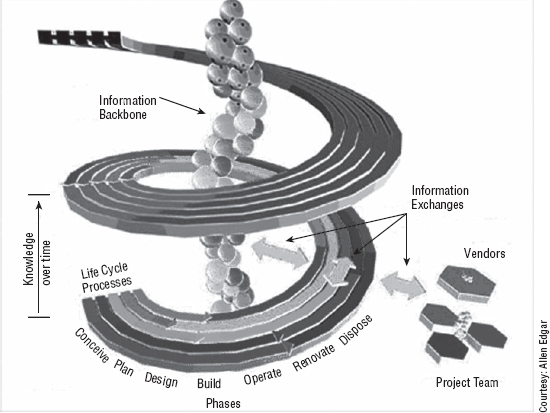Preparing for Collaboration
Working alone in Revit will deliver measureable increases in productivity, quality, and consistency; however, the true benefit of BIM is the ability to effectively collaborate between design disciplines with contractors and deliver useful data to facility operators.
SOCIAL BIM
The difference between these working paradigms has been described as lonely BIM vs. social BIM by John Tocci of Tocci Building Corporation (www.tocci.com), which is a forward-thinking construction company with headquarters in Woburn, Massachusetts. Lonely BIM can also be referred to as the use of “isolated BIM techniques for targeted tasks,” whereas social BIM is the underpinning for the goals set forth by organizations such as the National Institute of Building Sciences' (NIBS) buildingSMART Alliance (according to Penn State's BIM wiki at http://bim.wikispaces.com/BIM+Project+Execution+Planning+Project). The ability to support information exchanges, such as the facility life cycle helix concept shown in Figure 7.1, necessitates the proper use of 3D models and nongraphic data in a highly collaborative environment. Furthermore, the buildingSMART Alliance and the National BIM Standard (NBIMS) stress the need for platform-neutral, open interoperability between applications, not just within a program such as Revit.
FIGURE 7.1 BIM data exchanges according to NBIMS
BIM EXECUTION PLAN
Once a project team decides to participate in social BIM—either through desire or the requirements of a client—they must decide how to deliver this information in a useful way to all constituents throughout the project life cycle. Whether your client requires it or not, you should develop a BIM execution plan to define the goals, exchanges, and results related to the use of BIM.
The buildingSMART Alliance (www.buildingsmartalliance.org)—in an effort sponsored by the Charles Pankow Foundation, The Construction Industry Institute, Penn State Office of Physical Plant, and the Partnership for Achieving Construction Excellence (PACE)—has created a BIM Execution Planning Guide and template BIM Execution Guide. You can find the two guides at the Penn State Computer-Integrated Construction (CIC) website: www.engr.psu.edu/ae/cic/bimex.
One of the most critical parts of a BIM execution plan is the definition of the goals and uses of BIM. If you are just beginning your implementation of Revit, perhaps you are using it because it is the latest parametric program to enter the AEC industry, or perhaps you are attempting to increase your drafting productivity. Defining clear and concise reasons for implementing BIM on each project will help you define where to concentrate your modeling efforts. According to the buildingSMART Alliance, “[A] current challenge and opportunity faced by the early project planning team is to identify the most appropriate uses for Building Information Modeling on a project given the project characteristics, participants' goals and capabilities, and the desired risk allocations.” A listing of the common uses of BIM along with potential value opportunities and required resources is also available on the Penn State CIC website.
According to the American Institute of Architects' (AIA) “Integrated Project Delivery: A Guide,” a BIM execution plan “should define the scope of BIM implementation on the project, identify the process flow for BIM tasks, define the information exchanges between parties, and describe the required project and company infrastructure needed to support the implementation.” To be clear, the development of such a plan does not imply the application of integrated project delivery (IPD). IPD is “a project delivery approach that integrates people, systems, business structures and practices into a process that collaboratively harnesses the talents and insights of all participants to optimize project results, increase value to the owner, reduce waste, and maximize efficiency through all phases of design, fabrication, and construction.” For the purpose of this chapter, we will consider only the collaboration and coordination between members of a project design team, not the interactions with a client or contractor.
For additional reading on IPD, refer to these sources:
- IPD and BIM white papers by Ted Sive: www.tedsive.com
- Integrated Practice/Integrated Project Delivery: www.aia.org/ipd
- buildingSMART Alliance: www.buildingsmartalliance.org
- McGraw-Hill Construction, BIM Special Section: bim.construction.com

